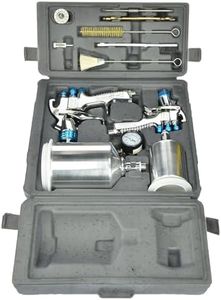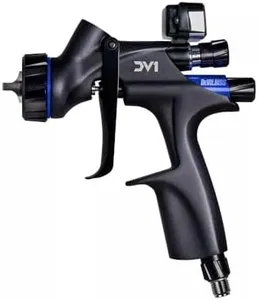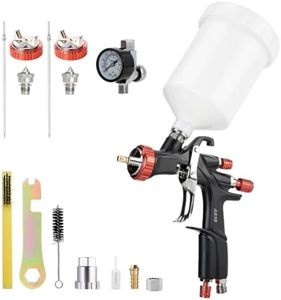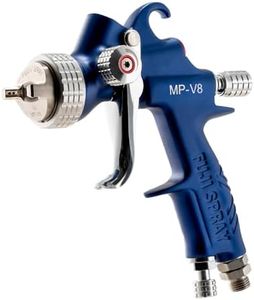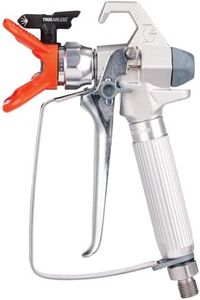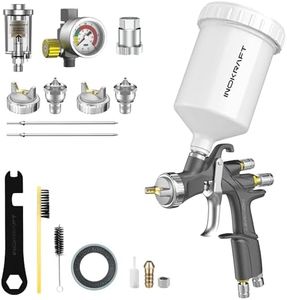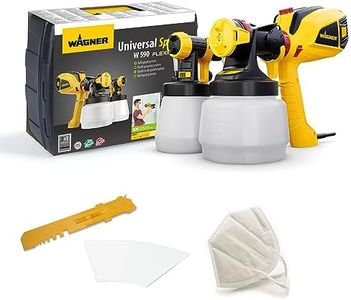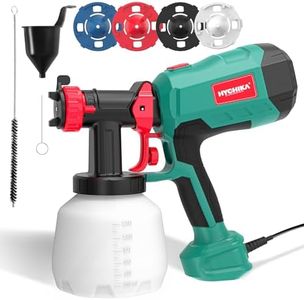We Use CookiesWe use cookies to enhance the security, performance,
functionality and for analytical and promotional activities. By continuing to browse this site you
are agreeing to our privacy policy
10 Best Paint Spray Gun
From leading brands and best sellers available on the web.Buying Guide for the Best Paint Spray Gun
Choosing the right paint spray gun can transform your painting experience, making tasks quicker, easier, and giving better results compared to traditional brushes or rollers. It's important to understand your specific projects, the surfaces you'll be working on, and the paints you'll use. Learn about the main features so you can pick a spray gun that fits your needs, ensuring smooth operation and professional-looking finishes.Type of Spray GunThe type of spray gun refers to how the device atomizes and delivers paint. The common types are airless, HVLP (High Volume Low Pressure), and conventional compressed air spray guns. Airless guns are powerful and great for covering large areas quickly, but can be harder to control for detail work. HVLP guns are more precise and waste less paint, making them perfect for smaller projects or detailed surfaces. Conventional spray guns are versatile but tend to use more paint and create more overspray. Consider the type of work you do most: large fences or walls suit airless, while cabinets or furniture benefit from HVLP.
Nozzle/Tip SizeNozzle or tip size determines how much paint comes out and how wide the spray pattern is. Smaller tips (typically under 1.4 mm) work well for thin materials like stains and lacquers, ideal for fine finishing. Medium tips (1.4 mm–1.8 mm) are best for general purpose paints like enamels and base coats. Larger tips (over 1.8 mm) handle heavy materials like primers and latex paint, used mostly for broad surfaces. Choose the size based on the thickness of the paint and the detail you need; smaller for intricate work, larger for big, rougher areas.
Paint CapacityPaint capacity is the amount of paint the spray gun can hold before needing a refill. Smaller paint cups (under 600 ml) are lighter, easier to maneuver, and good for touch-ups or detail work, but need refilling often. Medium cups (600–1000 ml) offer a balance between weight and working time. Larger paint containers are useful for big jobs with fewer interruptions, but can make the tool heavier and harder to handle overhead or for long periods. Think about your project size: small projects or detailed jobs suit smaller cups, while large surfaces benefit from bigger capacity.
Adjustability and ControlsAdjustability includes the ability to change the spray pattern (such as circular, vertical, or horizontal), flow control, and pressure adjustments. More control options mean you can fine-tune the application for different surfaces or paint types. Simple guns may only offer basic adjustments and suit straightforward tasks, while advanced controls are helpful if you tackle a range of projects. Consider how much flexibility you want or need based on your typical projects and how much you enjoy having detailed control.
Ease of CleaningEase of cleaning determines how much effort and time you’ll spend keeping your spray gun in good shape. Some spray guns have to be fully taken apart for cleaning, while others are designed with quick-release parts and fewer components. If you plan to use different colors or finishes back-to-back, or if you value convenience, look for a spray gun known for fast clean-up. Those doing a lot of painting or switching between different jobs will benefit most from easy-to-clean models.
Weight and ErgonomicsWeight and ergonomics affect comfort, especially during long jobs. Lighter spray guns reduce tiredness, while well-designed handles and triggers make the tool easier to control. Heavier guns might be more durable but could cause strain if used overhead or for extended periods. Choose a gun that feels comfortable and balanced in your hand, especially if you plan to paint for many hours or have multiple projects.


